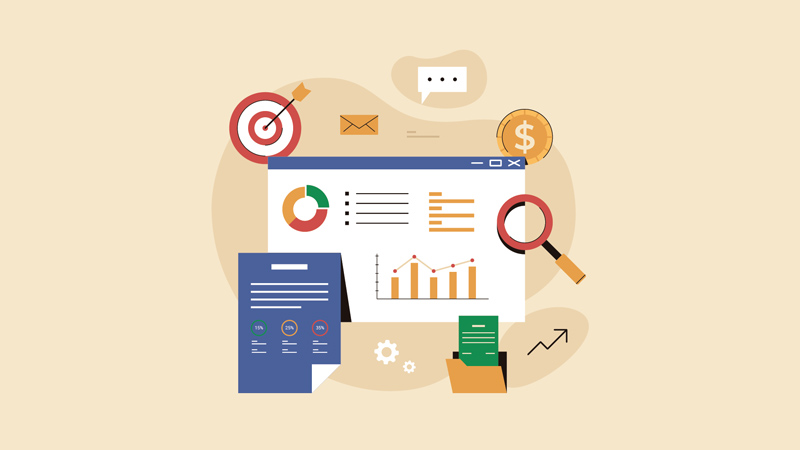What is Marketing Analytics?
Marketing analytics is the practice of measuring, managing, and analyzing marketing performance to maximize its effectiveness and optimize return on investment (ROI). It involves the use of data analytics tools and techniques to evaluate various marketing efforts, such as advertising campaigns, social media activities, email marketing, and website performance.
Marketing analytics aims to provide insights into customer behavior, preferences, and interactions with marketing channels. By collecting and analyzing data from multiple sources, such as website traffic, social media engagement, sales figures, and customer demographics, marketers can make informed decisions to improve their strategies and achieve better results.
Some common techniques and metrics used in marketing analytics include:
- Customer Segmentation: Dividing the customer base into groups based on shared characteristics to better target marketing efforts.
- ROI Analysis: Evaluating the return on investment for different marketing campaigns and channels to allocate resources effectively.
- Attribution Modeling: Determining the contribution of each marketing touchpoint to a conversion or sale.
- Customer Lifetime Value (CLV): Predicting the value a customer will bring to the business over their entire relationship with the company.
- A/B Testing: Experimenting with different versions of marketing materials or strategies to identify the most effective ones.
Overall, marketing analytics helps businesses make data-driven decisions, optimize marketing spend, enhance customer engagement, and ultimately drive growth and profitability.
Importance of Marketing Analytics
Marketing analytics is important for several reasons:
1. Data-Driven Decision Making
Marketing analytics allows businesses to make informed decisions based on data rather than assumptions or intuition. By analyzing various metrics and performance indicators, marketers can identify what works and what doesn’t, leading to more effective strategies and resource allocation.
2. Measuring ROI
Marketing efforts involve significant investments in terms of time, money, and resources. Marketing analytics helps measure the return on investment (ROI) of different campaigns and channels, allowing businesses to optimize their marketing spend and maximize profitability.
3. Understanding Customer Behavior
By analyzing customer data, marketers gain insights into consumer behavior, preferences, and buying patterns. This understanding enables them to tailor marketing strategies, messages, and offerings to better meet customer needs and preferences.
4. Optimizing Marketing Strategies
Marketing analytics enables continuous improvement by providing insights into which strategies, channels, and tactics are most effective in reaching and engaging the target audience. Marketers can refine their approaches based on data-driven insights to achieve better results over time.
5. Identifying Opportunities and Challenges
Through thorough analysis of marketing data, businesses can identify emerging trends, market opportunities, and potential threats or challenges. This proactive approach allows organizations to capitalize on opportunities and address challenges before they escalate.
6. Enhancing Customer Experience
By understanding customer behavior and preferences, marketers can personalize marketing messages and experiences, leading to higher levels of customer satisfaction and loyalty. Marketing analytics helps identify areas for improvement in the customer journey and enables the delivery of more relevant and timely communications.
7. Competitive Advantage
Businesses that leverage marketing analytics effectively gain a competitive advantage by staying ahead of the curve. By monitoring competitors, analyzing market trends, and understanding customer needs, companies can differentiate themselves and position their offerings more effectively in the market.
Overall, marketing analytics empowers businesses to make data-driven decisions, improve marketing effectiveness, drive revenue growth, and build stronger relationships with customers. In today’s data-driven world, it’s essential for organizations to harness the power of marketing analytics to stay competitive and achieve their business objectives.
11 Types of Marketing Analytics Tools
Marketing analytics tools come in various forms, each tailored to different aspects of marketing analysis. Here are some common types of marketing analytics tools:
1. Web Analytics Tools
These tools focus on analyzing website traffic, user behavior, and conversion rates. Examples include Google Analytics, Adobe Analytics, and Matomo (formerly Piwik).
2. SEO Analytics Tools
These tools focus on analyzing search engine optimization (SEO) performance, including keyword rankings, backlinks, site audit, and competitor analysis. Examples include SEMrush, Ahrefs, Moz Pro, and Google Search Console.
3. Email Marketing Analytics Tools
These tools track the performance of email campaigns, including open rates, click-through rates, conversion rates, and subscriber engagement. Examples include Mailchimp, Mailmodo, Bravo and more.
4. Advertising Analytics Tools
These tools measure the effectiveness of advertising campaigns across various channels, such as search ads, display ads, and social media ads. Examples include Google Ads (formerly Google AdWords), Facebook Ads Manager, and LinkedIn Campaign Manager.
5. Social Media Analytics Tools
These tools provide insights into social media performance, audience demographics, engagement metrics, and sentiment analysis. Examples include Sprout Social, Hootsuite, and Buffer.
6. Marketing Automation Platforms
These tools automate marketing tasks and workflows while providing analytics capabilities to track campaign performance and customer interactions. Examples include Marketo, Pardot, and Eloqua (Oracle Marketing Cloud).
7. Attribution Modeling Tools
These tools help marketers understand the contribution of each marketing touchpoint to conversions or sales by assigning credit based on different attribution models. Examples include Google Analytics Attribution, Adobe Analytics Attribution, and Bizible.
8. Predictive Analytics Tools
These tools use advanced algorithms and machine learning techniques to forecast future trends, customer behavior, and marketing outcomes based on historical data. Examples include IBM Watson Marketing, SAS Customer Intelligence, and RapidMiner.
9. Data Visualization Tools
While not specific to marketing, these tools are used to create visually appealing and insightful dashboards and reports to communicate marketing insights effectively. Examples include, Google Data Studio, Power BI, and Tableau.
10. Survey and Feedback Tools
These tools collect feedback from customers through surveys, polls, and reviews, providing valuable insights into customer satisfaction, preferences, and opinions. Examples include SurveyMonkey, Qualtrics, and Trustpilot.
11. Customer Relationship Management (CRM) Tools
While primarily focused on managing customer relationships, many CRM tools also include analytics features to track sales performance, customer interactions, and marketing activities. Examples include HubSpot, Salesforce, etc.
These are just a few examples, and there are many other specialized tools and platforms available to meet the diverse needs of marketers in analyzing and optimizing their campaigns and strategies.
Marketing Analytics to Maximize Business Growth
Using marketing analytics effectively can significantly contribute to maximizing growth for your business. Here’s how you can leverage marketing analytics to achieve this:
- Set Clear Objectives: Start by defining clear, measurable objectives for your marketing efforts. Whether it’s increasing brand awareness, generating leads, boosting sales, or improving customer retention, having specific goals will guide your analytics efforts and help measure success.
- Collect Relevant Data: Identify the key performance indicators (KPIs) that align with your objectives and ensure you have the necessary data tracking mechanisms in place. This may include data from web analytics, social media platforms, email marketing tools, CRM systems, and advertising platforms.
- Analyze Data Regularly: Regularly analyze the data collected from various sources to gain insights into the effectiveness of your marketing activities. Search for trends, patterns, and correlations that can provide valuable insights for guiding your decision-making journey.
- Identify Opportunities and Challenges: Use marketing analytics to identify opportunities for improvement and areas where you may be facing challenges. For example, analyze customer behavior to uncover opportunities for cross-selling or upselling, or identify underperforming marketing channels that may need optimization.
- Optimize Marketing Strategies: Based on insights from marketing analytics, optimize your marketing strategies and tactics to maximize effectiveness. This could involve reallocating budget to high-performing channels, refining targeting criteria, adjusting messaging, or testing different creative elements.
- Personalize Customer Experiences: Utilize data-driven insights to personalize customer experiences across various touchpoints. Segment your audience based on demographics, behaviors, or preferences, and tailor marketing messages and offers accordingly to enhance engagement and satisfaction.
- Implement A/B Testing: Conduct A/B tests to experiment with different variations of marketing campaigns and messaging. Analyze the results to identify what resonates best with your audience and refine your strategies accordingly for continuous improvement.
- Measure ROI: Continuously track and measure the return on investment (ROI) of your marketing efforts using marketing analytics. Calculate the cost per acquisition (CPA), customer lifetime value (CLV), and other relevant metrics to ensure that your marketing activities are generating positive returns.
- Stay Agile and Adapt: In today’s rapidly changing business landscape, it’s essential to stay agile and adapt your marketing strategies based on evolving market trends and consumer behavior. Use marketing analytics to monitor performance in real-time and make data-driven adjustments as needed.
- Invest in Learning and Development: Invest in ongoing learning and development to enhance your understanding of marketing analytics tools and techniques. Stay updated on industry trends, best practices, and emerging technologies to ensure that you’re leveraging marketing analytics to its fullest potential.
By effectively utilizing marketing analytics to inform your decision-making process and optimize your marketing efforts, you can maximize growth and drive long-term success for your business.





